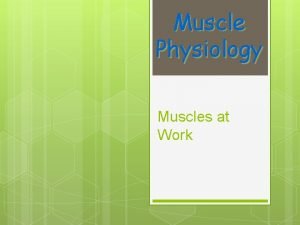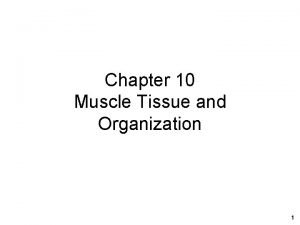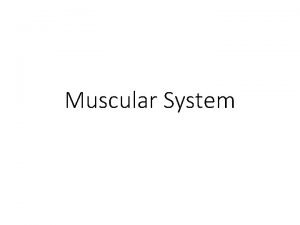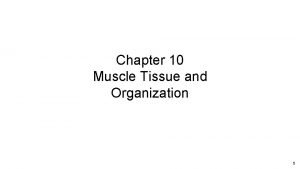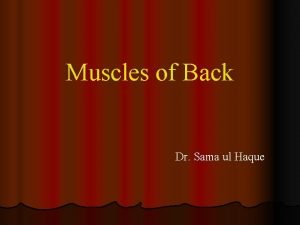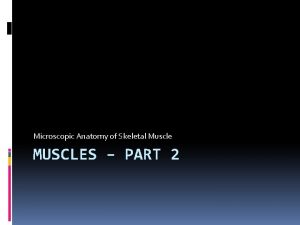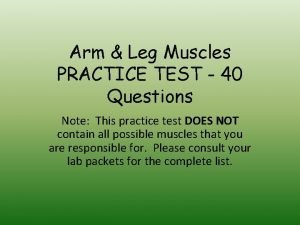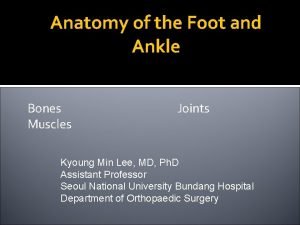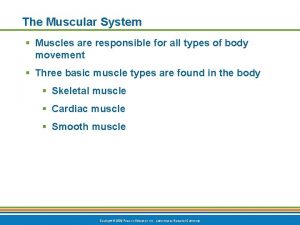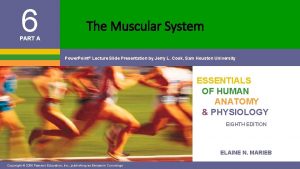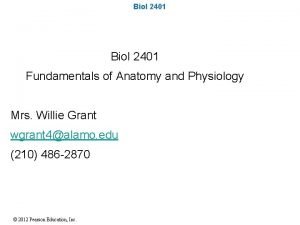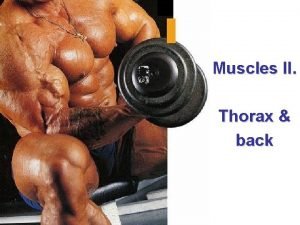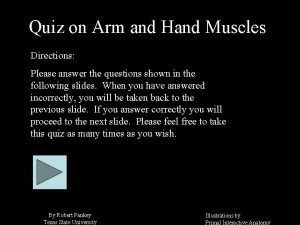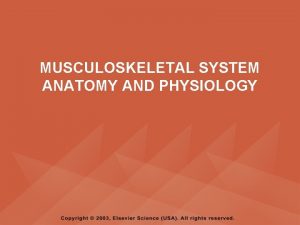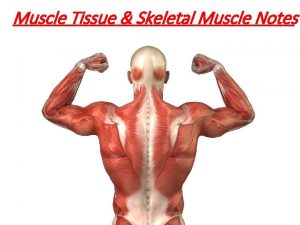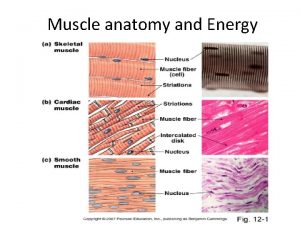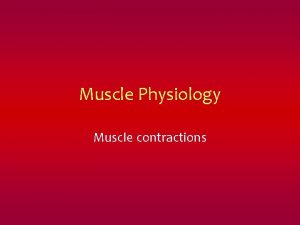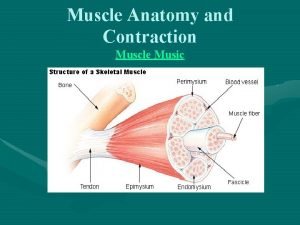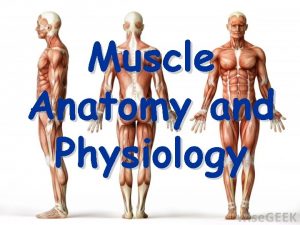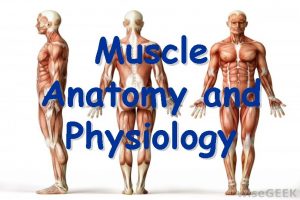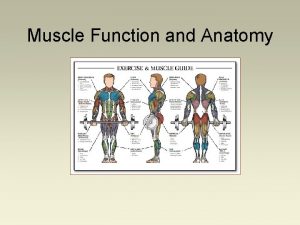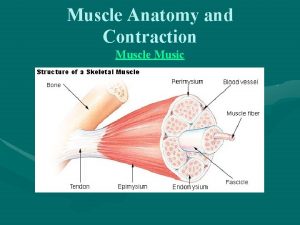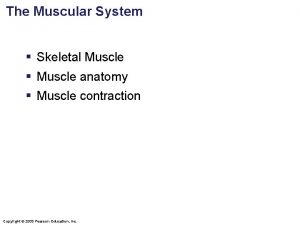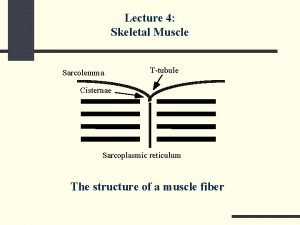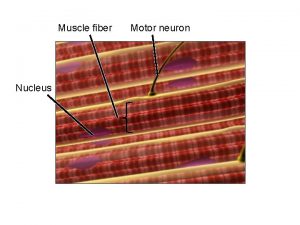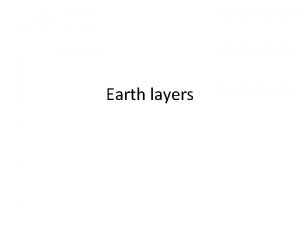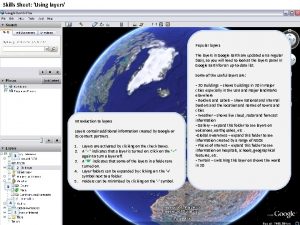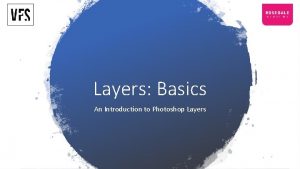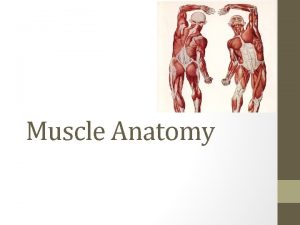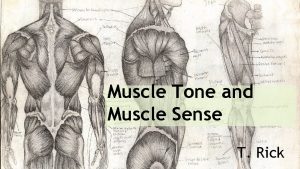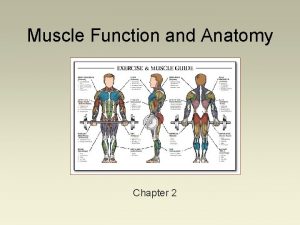Muscle anatomy and Energy Muscle Layers SARCOLEMMA Sarcolemma



















- Slides: 19

Muscle anatomy and Energy

Muscle Layers


SARCOLEMMA • Sarcolemma = muscle fiber membrane • Sarcoplasm = inner material surrounding fibers (like cytoplasm) • Myofibrils = individual muscle fibers --> made of myofilaments

Myofibril Contains protein filaments – ACTIN (thin) and MYOSIN (thick) These filaments overlap to form dark and light bands on the muscle fiber § A band = d. Ark • thick (myosin) § I band = l. Ight • th. In (actin) In the middle of each I band are Z lines. A sarcomere is on Z line to the other •





Muscles & Nervous System

Motor Unit or Neuromuscular Junction 1. Neuron 3. Vesicle 2. Sarcolemma (or motor end plate) 4. Synapse 5. Mitochondria

The neurotransmitter that crosses the gap is ACETYLCHOLINE. This is what activates the muscle. Acetylcholine is stored in vesicles


SLIDING FILAMENT THEORY (MODEL) • The theory of how muscle contracts is the sliding filament theory. The contraction of a muscle occurs as the thin filament slide past the thick filaments. The sliding filament theory involves five different molecules plus calcium ions. • The five molecules are: myosin actin tropomyosin troponin ATP

ANIMATION OF SLIDING FILAMENT • http: //www. blackwellpublishing. com/matthews/myosin. html

ENERGY • Fibers contain multiple mitochondria for energy • Most fibers have multiple nuclei • •

Energy Source • Provided by ATP from cellular respiration (mitochondria) • Creatine phosphate increases regeneration of ATP • Much of the energy forms heat, which keeps our bodies warm


• Muscle Fatigue - muscle loses ability to contract after prolonged exercise or strain • Muscle Cramp - a sustained involuntary contraction • Oxygen Debt - oxygen is used to create ATP, during exercise you may not have enough oxygen --> this causes Lactic Acid to accumulate in the muscles •
 Sarcolemma vs perimysium
Sarcolemma vs perimysium Convergent muscle
Convergent muscle Muscle root word
Muscle root word What connects a muscle to a bone
What connects a muscle to a bone Layers of scrotum anatomy
Layers of scrotum anatomy Energy energy transfer and general energy analysis
Energy energy transfer and general energy analysis Energy energy transfer and general energy analysis
Energy energy transfer and general energy analysis 3 layers of muscle
3 layers of muscle Back muscle layers
Back muscle layers Microscopic anatomy of skeletal muscle
Microscopic anatomy of skeletal muscle Leg muscle anatomy
Leg muscle anatomy Gastrocenimus
Gastrocenimus Microscopic anatomy of skeletal muscle figure 6-2
Microscopic anatomy of skeletal muscle figure 6-2 Microscopic anatomy of skeletal muscle figure 6-2
Microscopic anatomy of skeletal muscle figure 6-2 Microscopic anatomy of skeletal muscle figure 6-2
Microscopic anatomy of skeletal muscle figure 6-2 Muscle anatomy
Muscle anatomy Ligamentum arcuatum mediale
Ligamentum arcuatum mediale Muscular hands
Muscular hands Pyramid muscle anatomy
Pyramid muscle anatomy Skeletal muscle
Skeletal muscle
